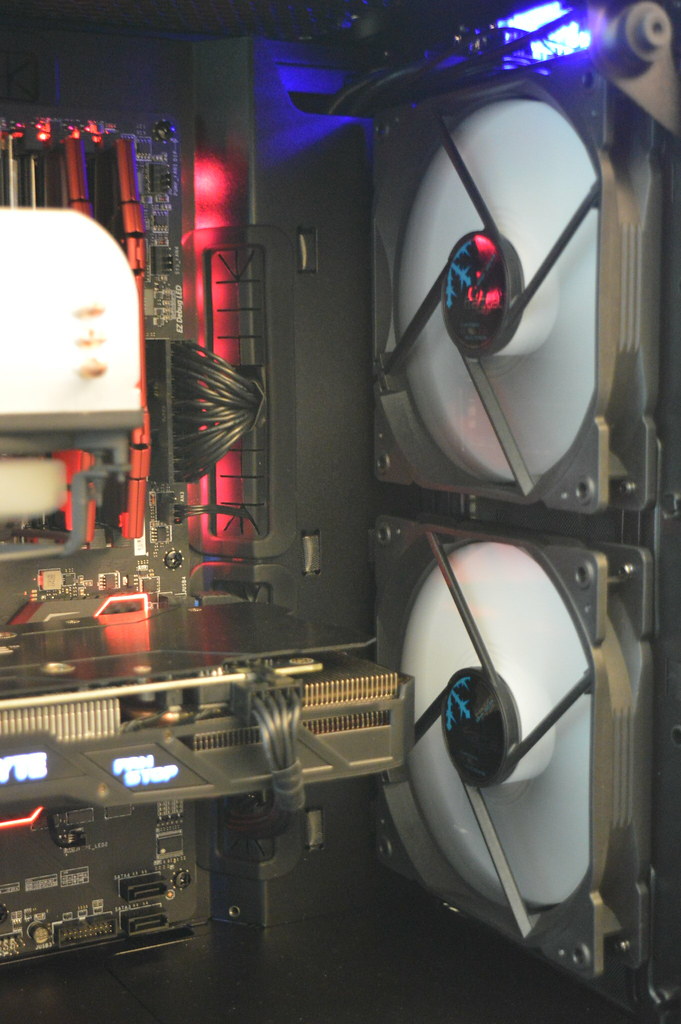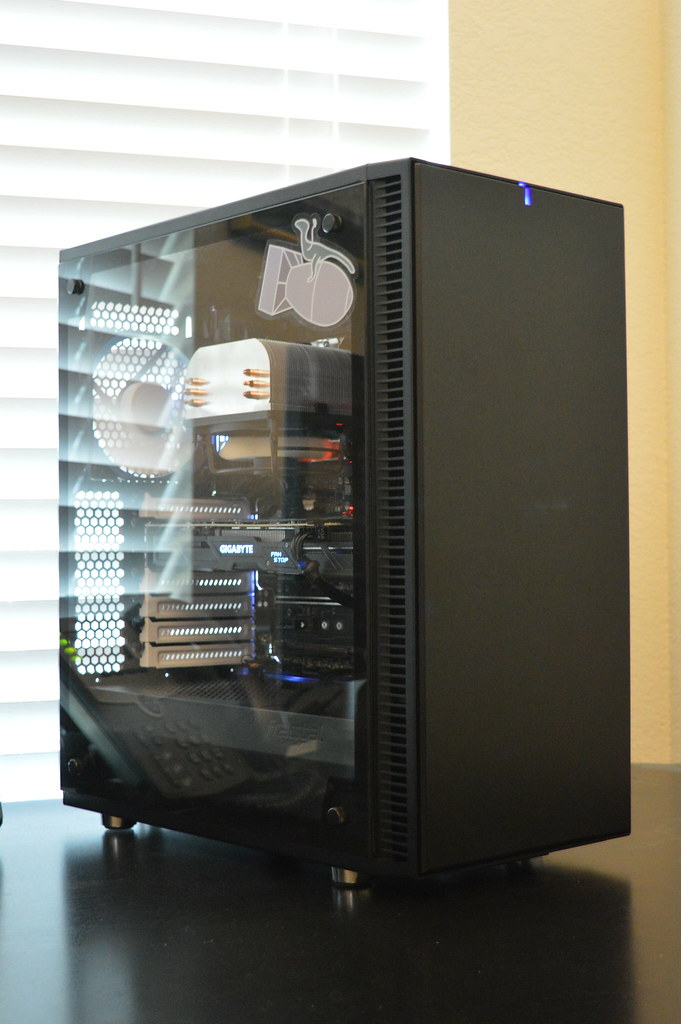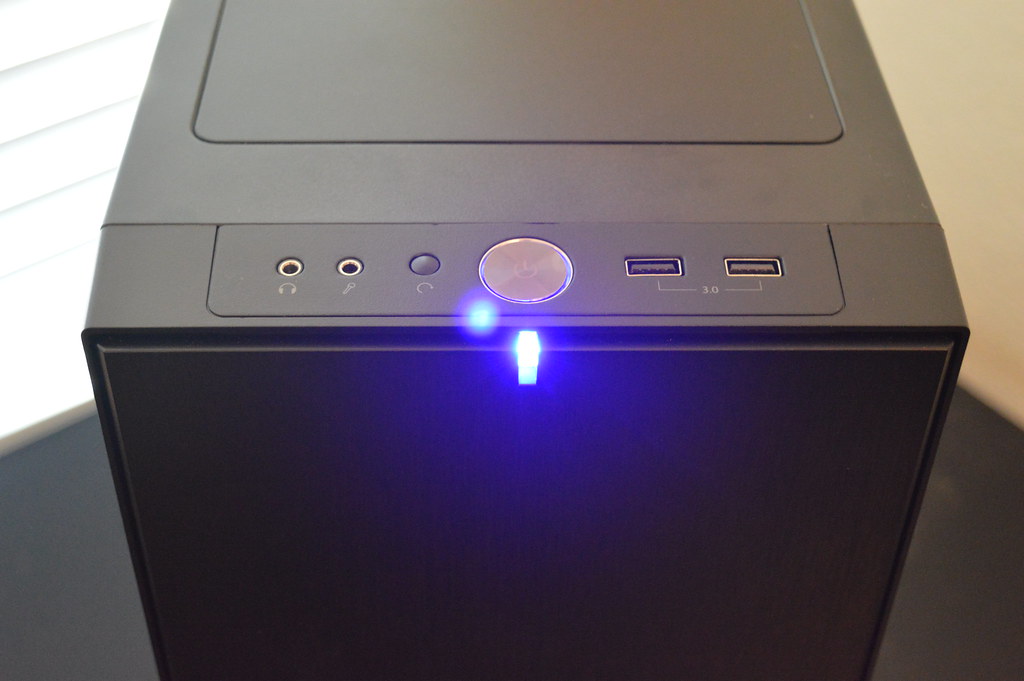Amy, the Above Average Gaming PC
As I mentioned in a previous post, my home systems are named after Futurama characters. The only hard rule I’ve had is I’ve never used “the big three” because I didn’t want to assign assumed significance to them, but other than that, the only loose sub-convention is women tend to be laptops and desktops.

leo and inez (Amy’s parents) are the G4 Mac Minis. nibbler is the main router and “omniserver”. linda (Morbo’s newscast co-host) is my laptop, a Lenovo ThinkPad X250. ndnd (Lrrr’s wife) is a (“modern”; 6 years old) Mac Mini media server. And amy is my Windows gaming PC. When I replace a “standard” computer, I’ll keep the same name; for example, my main laptop has always been named linda.
(While I don’t anthropomorphize my computers, I found it awkward to write the rest of this post while mixing e.g. amy and “it” in the same sentence. So for the sake of convenience and narrative, sometimes I’ll be using gender pronouns, sometimes I won’t.)
amy had been getting a little outdated. Normally what I tend to do is make incremental upgrades of desktop computers every other year or so. A full list is here at pcpartpicker.com, but in general, all of the main components were 4 to 5 years old:
- Intel Core i5-3570K
- 32GB DDR3 RAM
- Dual AMD Radeon HD 7790
- Unless you’re seriously into a single game which has good support for SLI/CrossFire, I’d recommend not doing it, as overall compatibility can be a nightmare.
- 250GB Samsung 840 Pro SSD + 2TB WD Black HDD
A pretty decent system at the time, but it’s dated. Notably, a month or so ago I bought and tried to play Player Unknown’s Battlegrounds. Even at lowest settings, it was nearly unplayable. That was the first time I took advantage of Steam’s refunds.
So this month I decided to build a new gaming PC (also to be named amy). AMD Ryzen is the new hotness, so I went that route. I don’t think I’ve built an AMD system since Intel introduced its Core CPUs; the last AMD system was probably an Athlon 64 X2. And while the AMD Vega video cards were just released, they’re not very price competitive. Nvidia GeForce 10 series are somewhat expensive too due to Bitcoin miners, but an okay deal can be had on a 1060.
As previously mentioned, I have tended to do incremental builds: buy about 30-50% new components to replace, and re-use 50-70% of an existing system’s components. I don’t think I’ve ever spent more than $750 at a time on computer components. But as it’s been more than a few years since I’ve done this, I decided to build a completely new system, from the case up.
Let’s just say, I spent a bit more than $750. It wasn’t exactly “money is no object”, but I did suppress my urge to try to save little bits here and there. “Hmm, the Western Digital 256GB NVMe drive is $100 and should work OK… But I know the Samsung 960 EVO will be good and is only $20 more.”
Of course, those little splurges add up over the course of an order, and the initial cost after shipping and tax ended up being $1,599.95 (no, really). It’s not exactly a top of the line gaming PC, but it’s comfortably above average in every respect. Hence the name.
Amy doesn’t like to brag. She’ll freely admit she’s not a Threadripper with triple 1080 Tis and liquid nitrogen cooling. But she’s pretty good. Sufficient. Above average. She once wrote a song which her friends liked, but doesn’t plan to go pro or anything. She enjoys dim sum. She has a 780 credit score. — Amy, the Above Average Gaming PC
 I’ll admit, I went with the Fractal Design Define C Tempered Glass case because I thought it looked sexy, in an understated way. Of course, the RGB lighting which happened to come on the motherboard and graphics card belies that understated tone, but it still works.
I’ll admit, I went with the Fractal Design Define C Tempered Glass case because I thought it looked sexy, in an understated way. Of course, the RGB lighting which happened to come on the motherboard and graphics card belies that understated tone, but it still works.
This is the first time I’ve ever put even modest effort into cable routing and presentation in a case. Ten years ago, nobody would have considered routing most of the system’s cables behind the main motherboard tray, but now you have cases which are built with that in mind, with cable management channels, rubber grommets between the front and back, and PSU/hard drive basements. The result is a clean, simple layout in the front which lends itself well to display behind glass.
The specs are very respectable and should last awhile:
- AMD Ryzen 5 1600X
- 32GB DDR4 RAM
- 2x 16GB sticks with 2 slots free; I believe since it’s at 2400MHz, 64GB should be possible in the future
- Nvidia GeForce GTX 1060 6GB
- 250GB Samsung 960 EVO NVMe SSD + 2TB Seagate FireCuda SSHD
I had originally ordered a Cooler Master Hyper T4, but realized after it arrived that the only native AM4 mounting direction is vertically, which would have blocked 3 of the 4 memory slots. Luckily I had a new Arctic Freezer 7 Pro, which I don’t even remember buying, but it was in a box in storage. It fits, and goes with the black/white aesthetics of the Fractal Design case.
I still don’t like how the cooler is mounted vertically, and will probably go with a Hyper 212 EVO and AM4 bracket eventually. The problem is the AM4 bracket must be ordered directly from Cooler Master, so it may take awhile. But thermals aren’t a problem; I’m not overclocking, have two 140mm intake fans and one 120mm exhaust, so air is constantly moving within and out of the case.
The first game I played on the new system? Flaunting technology, I played the original Half-Life, which is 20 years old this year. The graphics card didn’t even bother to turn on its fan.

